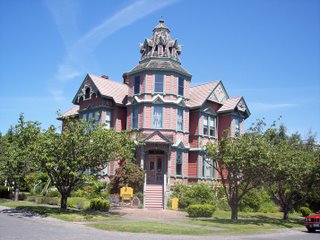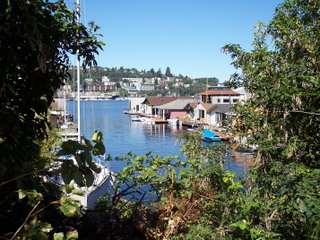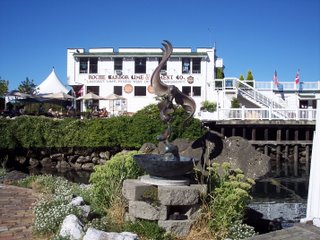
BIRTH OF MARINERS' COVE
by Barbara Weyer
2126 Stoney Beach Lane
Oak Harbor, Washington
"On the shores of a pleasant little point, in that distant time, surrounded by virgin forests on the one side and sparkling blue saltwater on the other, thronged a horde of red savages. Forty or more mongrel dogs, shorn as close as sheep, sniffed and yelped around the group or raced away over the small bits of prairie which stretched between the heavily wooded ridges." Author unknown.
"Aside from the cries of small babies and a few naked children, the two hundred partly blanketed copper figures were standing in amazed attention. All eyes were focused toward the center of the group. There stood a man in the uniform of the Ship's Master in the Royal Navy of King George III. It was Saturday, the 2nd of June, 1792.
Representatives of two branches of the human biological tree stood examining one another. For the first time in the eons of development, scions of the Skagit tribe looked upon a white man. The native sons of the Island, tscga-kale-chey, faced the man whose name was to be given to their native land--Master Joseph Whidbey."
There had been many visits to the Island by white men in the period between 1792 and 1840, but civilization was yet to come.
The Oregon Donation Land Law was passed by Congress on September 27, 1850, and applied to all of the Old Oregon Territory, within which was Whidbey Island. First settlements were on the West shore of the Island across from Port Townsend. This was followed by settlements in Penn Cove and Oak Harbor.
In 1854 Charles Miller took the Northernmost claim on the Eastern shore of Whidbey and George Allen located back from the shore at Oak Harbor. In the 1860's and 1870's, once all the good land was taken, the population growth did not increase.
After a decade, in 1880 the Northeast portion of Whidbey Island was settled by pioneers from the Nordic countries, who had very little communication with the surrounding areas. The closest trading centers were Utsalady, on Camano Island's North shore, and the booming little town of La Conner on the Swinomish Slough, a close seven miles by boat.
The Langlands, a pioneer family, came from sturdy Viking stock that had weathered years of blizzards, grasshoppers, scourge and illness pioneering in Minnesota after their grandparents had come from Norway to the new land. A handwritten account by Olga Langland Simonson's father of his childhood in Minnnesota prepares one for an understanding of how these sturdy people undertook carving out a home on Whidbey Island when Indians were the only residents.
Olga's father was sent as a young boy of seventeen to the West Coast to scout the possibility of the family settling here. He arrived at Utsalady on Camano Island and went to work in the mill that was famous for lumber the world over. (Goodwill Matson, a long-time resident of this area, remembers his father saying that lie saw 14 sailing Ships from all over the world waiting to take on lumber.) Olga's father had never seen a sawmill before. What should he tell his parents to do? There did not seem to be a place out here for those who would till the soil. He wrote:
"The forest crowds so close right down to the sea with trees up to 10 feet in diameter".
The parents did come and after working nine years ill sawmills, purchased 138 acres above Bran's logging camp on Wlhidbey Island, (which later will be know as Olson's Landing. Pilings at the former location of the lauding still stand at the opening from Saratoga passage to the canals of Mariners Cove.) They were pioneers in the true sense of the word. The father could do anything, mend shoes, do carpentry, make furniture, as well as farm.
They soon cleared the sloping hillside of timber and planted gooseberries, strawberries, currants, and then tomatoes. It was difficult at first because people did not know what they were. However, people soon learned, and in one year they sold twenty-two tons. The produce was loaded aboard the steamship "Fairhaven" in mid-current from a row boat.
The women in the family, in addition to their duties of raising 500 chicks, attending to the house and gardens, corded, spun and wove wool to make rugs. Olga's mother wove 100 yards one summer for a woman in La Conner for which she was paid 10 cents a yard. The children of the area attended school in a one-room schoolhouse handling all eight grades. They learned by hearing others recite. Among the pioneer families attending the school were the Langlands, Seigfieds, Matsons, Frostads, Ellwongers, Borgmans, Liens, Hunskors, Olsons and Oyors. The schoolhouse was also a church on Sundays when a minister was available. If not, on Sunday the family dressed in their best clothes and the father read the Bible in the kitchen. Sunday afternoons were for visiting.
Another of the first families to settle in this area were the Hans Olsons, also of Norwegian ancestry. Hilda Olson, her parents and five brothers and sisters lived on a small island on the Skagit delta. When it came time for the children to attend school, Hilda's father, in 1906, purchased 60 acres of laud adjacent to the Langland property. This became known as Olson's Landing at the entry to the canals of Mariners' Cove from Saratoga Passage. Hilda remembers going with her father and brothers and sisters to trade in La Conner. " It was closer than walking through the woods to Oak Harbor," she said.
Hans Olson, Hilda's father, was also a carpenter and built their home and barns, as well as being a farmer. There was an area on their farm that made a natural entrance for a boat. He built a series of dikes to maintain water during the change of tides.
Olga tells of encounters with the Indians of the area. She said they were friendly but were constantly in need of food. They were particularly found of potatoes and would at times help themselves.
In 1924, a ferry route was established from Utsalady to Olson's Landing. It could carry ten cars, as well as foot passengers and made 3 trips a day. The three Olson brother--August, Albert, and Oscar (not related to the Hans Olson family) who owned and operated the ferry held a contest among the school children to find a name for the new ferry. The name "Acorn" was selected.
Howard Olson, no relation to either of the other Olson families, who resided in Utsalady, remembers riding the ferry. As a six year-old child he was allowed to steer the vessel on many crossings. They always made a trip over in August to view the Indian Water Festival held in Coupeville, and dedicated to Chief Charlie Snakeelum. The Water Festival, consisting of eight Washington and ten British Columbian Indian canoes, had such picturesque names as Rolling Thunder, and Shadow of Valdez.
The ferry continued to run until after the Deception Pass bridge was completed, stopping service in 1935 or 1936.
In 1965 Hilda Olson Hunskor and her brother sold the large portion of Olson's Landing to land developers Charles Reisdorf and Milo Norton. The original purchase price by the Olson family was $1500. The property was sold to the developers for in excess of $250,000.
From 1965-1967 the developers dredged a series of canals on the property forming a marina. The 180,000 cubic yards of dirt that was excavated to make this possible was used to fill in the low-lying swampy areas of the development. The area, now know as Mariners' Cove, was divided into 169 building lots. The first person to build a home in this area was Richard Pitt, now a retired Superior Court Judge. Most of the lots sold, but building did not begin to develop until about 1972. There are presently about 98 residences with more slated for construction. It is interesting to note that this area did not have electricity until 1932.
Hilda Olson Hunskor still resides in the family home. There is a cherry tree in her yard that is over 100 years old, and still bearing fruit. It blocks her view of Mariners Cove, ... she likes it that way.
Revised 1995 . (End of article)
To learn more about the status of Mariners Cove and Oak Harbor today, go to
www.oakharborchamber.org and
www.BoatCommunities.com


 MARINERS COVE - Beautiful community in Oak Harbor on Whidbey Island consisting of 170 home sites of which approximately 150 have homes on them, some on canals with private docks in their backyard, or beachfront, or expansive water views of Saratoga Passage. There are two community docks with boat slips available for those who have a boat but no private dock. The residents share the Cove with eagles, great blue herons and sea otters. Mariners Cove is close to the facilities and festivities of Oak Harbor and Coupeville with easy marine access to the Deception Pass Bridge and the San Juan and Gulf Islands. Homes in Mariners Cove generally range from the high $300's to $1+million. Go to
MARINERS COVE - Beautiful community in Oak Harbor on Whidbey Island consisting of 170 home sites of which approximately 150 have homes on them, some on canals with private docks in their backyard, or beachfront, or expansive water views of Saratoga Passage. There are two community docks with boat slips available for those who have a boat but no private dock. The residents share the Cove with eagles, great blue herons and sea otters. Mariners Cove is close to the facilities and festivities of Oak Harbor and Coupeville with easy marine access to the Deception Pass Bridge and the San Juan and Gulf Islands. Homes in Mariners Cove generally range from the high $300's to $1+million. Go to 




